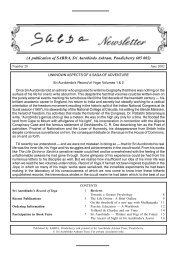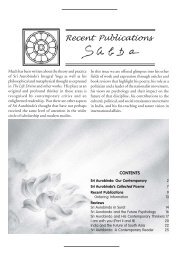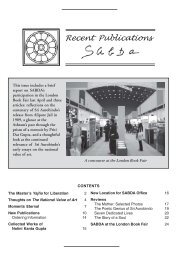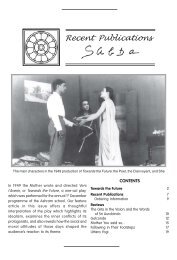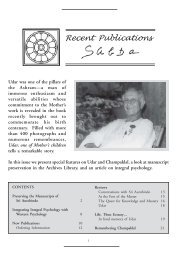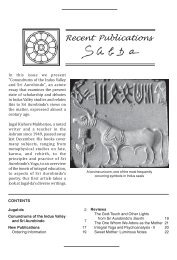Recent Publications - Sabda - Sri Aurobindo Ashram
Recent Publications - Sabda - Sri Aurobindo Ashram
Recent Publications - Sabda - Sri Aurobindo Ashram
You also want an ePaper? Increase the reach of your titles
YUMPU automatically turns print PDFs into web optimized ePapers that Google loves.
16 <strong>Recent</strong> <strong>Publications</strong><br />
into book form. Thirdly, the passages selected give a<br />
direct and practical feel. Many of the sentences chosen<br />
have a strong mantric appeal, musing on which can<br />
change one’s entire perspective on life. Finally, as in<br />
all compilations, it brings us directly in touch with the<br />
Force inherent in the words of <strong>Sri</strong> <strong>Aurobindo</strong> and the<br />
Mother.<br />
from a perspective of illumined experience. But the<br />
stamp of Truth can always be recognised. Therefore<br />
the discriminating reader will immediately perceive that<br />
when writing Nama-Japa in the Yoga of<br />
Transformation, <strong>Sri</strong> Ramkrishna Das was doing so as a<br />
man who had lived the yoga and embodied it in his<br />
own person.<br />
No doubt there are some omissions; also the stress<br />
is largely on the aspects of physical health. Perhaps<br />
that is why the title Towards Perfect Health is justified;<br />
the ‘towards’ holding out a hope of several other<br />
companion volumes to come that would cover all<br />
aspects of health from every side and give us a more<br />
complete picture. The present volume is rather like a<br />
trailer that gives us beautiful hints and suggestions; or<br />
as if the compilers have led us to their chosen spots on<br />
the banks of a wide river of knowledge and insight,<br />
inviting us to enter its purifying waters. It is now for<br />
the reader to decide how far and deep he or she wishes<br />
to go in their personal exploration.<br />
— Dr Alok Pandey<br />
Dr Pandey, psychiatrist and philosopher, is a seeker on the<br />
path of <strong>Sri</strong> <strong>Aurobindo</strong>’s yoga. He writes and lectures<br />
extensively on varied issues of life and yoga.<br />
Nama-Japa in the Yoga of Transformation<br />
— Ramkrishna Das; Published by Auro Seva Trust,<br />
Puducherry; 81 pp., Rs 60<br />
<strong>Sri</strong> Ramkrishna Das begins this work with a bold<br />
and uncompromising statement: “In the Yoga of<br />
Transformation, there is only one sure and certain way<br />
to overcome all seemingly insurmountable obstacles,<br />
to pass securely through even the most cunning and<br />
subtle attacks of the hostile forces and to safely reach<br />
the goal. This way is to surrender at the feet of the<br />
Mother like a small child and repeat her name. It is never<br />
safe to tread the path of this yoga without this<br />
impenetrable armour.” The rest of the book consists of<br />
a lucid and compelling illustration of this central theme.<br />
The words of a realised man carry a natural authority,<br />
power, and simplicity that cannot be imitated. Very few<br />
people can be said to be in a position to write about<br />
this yoga with any true authority and even fewer still<br />
could presume to write on the yoga of transformation<br />
Nama-japa has always been recognised as a potent<br />
means of realisation, not only in India but in all<br />
countries where mysticism has been practised. The<br />
Mother, however, took up japa for a new purpose—the<br />
transformation of the body. It is this practice of japa<br />
by the Mother herself and the statements that she made<br />
about it that support <strong>Sri</strong> Ramkrishna Das’ thesis that<br />
nama-japa is the only way to achieve the physical<br />
transformation. The Mother stated in 1959: “I have also<br />
come to realise that for this sadhana of the body, the<br />
mantra is essential…because only japa has a direct<br />
action on the body.”<br />
But according to the author, it is<br />
not only in the final stages of the<br />
yoga that nama-japa should be<br />
practised, rather that it is desirable<br />
to practise it from the very outset.<br />
For <strong>Sri</strong> Ramkrishna Das puts<br />
forward an idea of immense<br />
significance; namely, that there<br />
exists an essential identity between<br />
the supramental power, the Mother and the Mother’s<br />
name—‘Ma’. The natural implication of this is that the<br />
Mother’s presence and the transforming action of the<br />
supramental power are always with those who<br />
constantly repeat the Divine Name with a sincere<br />
attitude of aspiration and surrender. <strong>Sri</strong> Ramakrishna<br />
Das further emphasises that in this way even those who<br />
have only just begun their sadhana can quickly<br />
develop constant awareness and intense aspiration.<br />
Finally, and perhaps most importantly, what the<br />
reader actually encounters in this remarkable text is a<br />
powerful impulse pushing him to fulfil his ultimate<br />
spiritual destiny. He is shown the goal and shown also<br />
a straightforward and entirely safe and dependable<br />
means to achieve it—a simple reliance upon the name<br />
of the Divine Mother.<br />
— Jonathan Cooke<br />
Jonathan is a sculptor from England and has been a devotee<br />
of the Mother and <strong>Sri</strong> <strong>Aurobindo</strong> for a long time. Every year<br />
he spends several months here in Puducherry.



